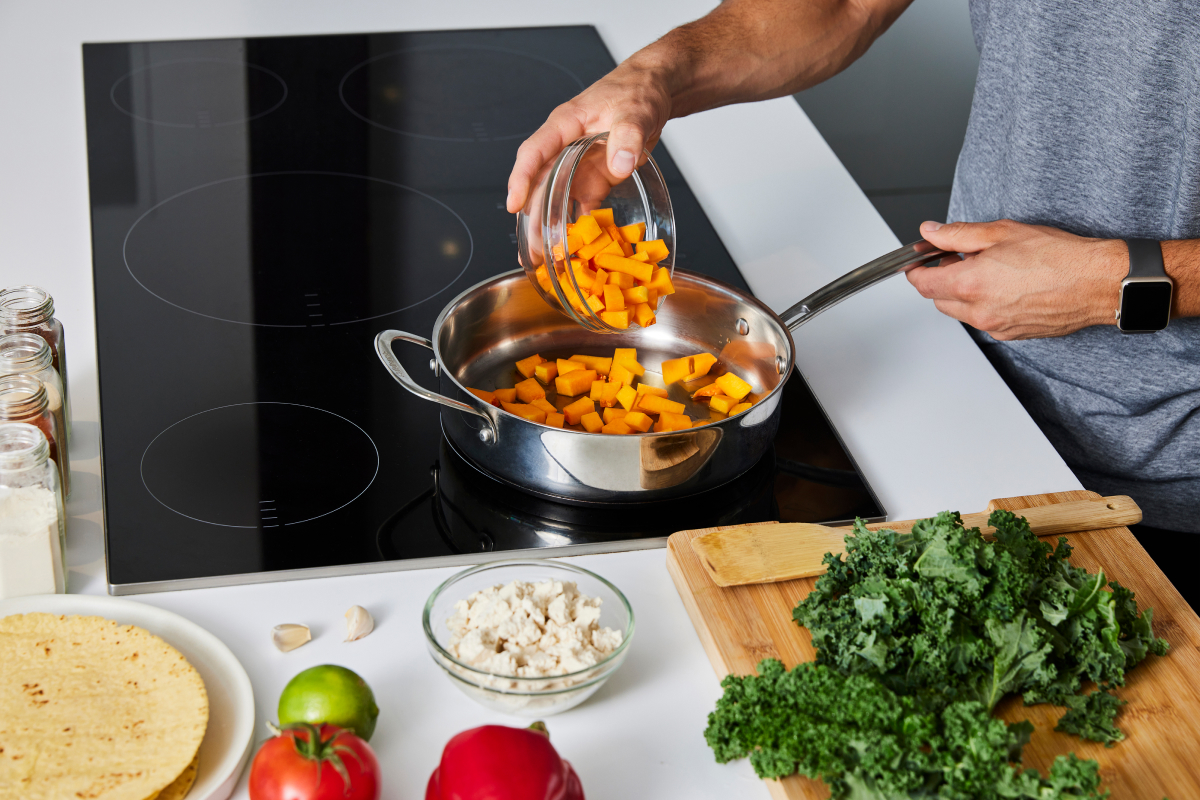Here’s what you should eat before a high-intensity session to perform at your best.

High-intensity interval training (or HIIT) has been shown to improve cardiovascular health , shift body composition , and boost muscular endurance . These fast-paced workouts are effective, but they’re also demanding, so you need to make sure you’re fueling correctly. Knowing what to eat before a HIIT workout can make the difference between feeling energized and powerful the whole way through, or dragging your feet and feeling weak.
Whether you’re searching for the right meal, considering pre-workout supplements , or sifting through carb-loading protocols , you want enough fuel to power those high-intensity intervals—without your most recent meal bouncing around in your stomach when you’re performing high-intensity resistance training or doing plyometrics .
Here are a few factors you should consider when deciding on what to eat before a HIIT workout.
What Should You Eat Before a HIIT Workout?
According to John Christie, registered dietitian and Tonal’s Director of Applied Training Science, you should prioritize carbohydrates and hydration before a HIIT workout. Carbs are essential as they provide readily available energy, while drinking fluids is important as you’ll lose water through sweat.
If you’re eating two to three hours before your HIIT workout, you can include protein and healthy fats for additional fuel. “Research shows that protein before your training can decrease your cortisol and stress response,” says Christie. High-intensity exercise temporarily raises levels of the stress hormone cortisol , and high cortisol levels can inhibit protein synthesis and muscle growth. By decreasing cortisol, protein blunts these negative effects and helps with recovery.
Tonal coach Ackeem Emmons , a personal trainer and certified Precision Nutrition Level 1 nutrition coach, likes to fuel his HIIT workouts with a mix of eggs, sweet potatoes, and okra with a complex carbohydrate such as quinoa, farro, or brown rice. This savory meal is easy to assemble and works any time of day. As Emmons says, “I’m big on having dinner for breakfast.”
For more options of what to eat before a HIIT workout that’s a few hours away, Christie recommends combining carbohydrates and protein (such as whole wheat toast or pancakes and eggs) or getting both in the same dish (for example, a yogurt parfait with fruit and granola).
As you get closer to your workout, you’ll want to rely more on fast-digesting, simple carbohydrates, such as a banana or toasted white bread, and keep protein moderate and fat low. If you’re eating within an hour of your HIIT workout, try low-fat yogurt, a smoothie, or a sports drink with carbohydrates. Emmons personally likes a protein shake, trail mix, or a peanut butter and jelly sandwich for quick pre-workout fuel.
“What ends up happening is that your blood will be diverted away from the digestion of food [as you exercise] and focus more on pumping nutrients to the muscles,” says Christie. “Undigested food will then just sit there like a rock.” Simple carbs will digest in time but meals that are heavy in fat or fiber take longer.

Can You Do HIIT on an Empty Stomach?
When you exercise first thing in the morning , you might not have the appetite for a full meal. In that case, you’re better off doing your HIIT workout even if it’s on an empty stomach—especially if that’s the only time in the day you have to work out.
“It certainly can be done, and you can make the most of it by continually showing up,” says Christie. “Consistency is the most important variable.” However, if you’re not fueling your workouts, you could be selling yourself short. Without available energy, you won’t be able to perform at the highest level of intensity you’re capable of, and you run the risk of feeling weak or light-headed.
Christie notes that you can gradually make small changes to your morning routine to get in more nutrients and boost your performance.
Start by simply hydrating with water before and during your workout. Once that becomes second nature, try adding beetroot juice or a pre-workout supplement with beta-alanine. A review of studies shows that beetroot juice can improve cardiovascular endurance and increase time to exhaustion. Similarly, studies have shown that beta-alanine can increase training volume while reducing feelings of fatigue , and improve performance in sprint interval training .
Beetroot juice contains nitrates, which expand blood vessels and improve the delivery of oxygen and nutrients to your muscles. Beta-alanine , Christie explains, helps improve an athlete’s capacity for training and increases the time to fatigue by buffering lactic acid buildup. Both of these are available as powders that mix in your water and go down easy.
“Those things make a small difference and they’re not a huge investment of energy and time,” says Christie.
Next, he suggests incorporating a sports drink or smoothie with carbohydrates to get in more fuel. In liquid form, these are easy to digest quickly before your workout.
If you don’t want a pre-workout supplement, Emmons suggests starting your morning with coffee before a workout.
Caffeine
has been shown to improve both endurance and strength performance.
How to Fuel The Night Before
Another strategy that Christie and Emmons both recommend, especially if you’re unsure what to eat before a HIIT workout, is to top off your energy stores the night before your workout n with a healthy dinner or snack.
“In my days of running track, when we had a track meet early in the morning our coach would tell us to load up on everything the night before,” says Emmons. “If you didn’t have dinner and then you wake up early, that is a huge window [without eating]. That is just a recipe for disaster.”
When fueling the night before, choose foods that digest more slowly so the energy will be readily available in the morning when you need it. Go for complex carbohydrates instead of simple ones (think whole wheat bread over white bread) and add protein and healthy fat to your meal. Christie explains that fat delays gastric emptying, slowing the digestion process so you’ll still have fuel in your system in the morning.
Emmons recommends including foods like sweet potato or guacamole in your evening meal to add complex carbs and healthy fats, and pairing them with a lean protein like salmon .

HIIT Workouts on Tonal
Now that you know what to eat before a HIIT workout, here are some high-intensity Tonal programs and sessions you’ll be ready to take on, fully fueled.
Super Power HIIT – Coach Ackeem Emmons
This fast-paced, full-body interval workout taps into Tonal’s dynamic weight modes to give your muscles even more of a challenge. You’ll focus on power and velocity, and finish the session with a burnout block to test your endurance.
HIIT Hard, Recover Harder – Coach Ash Wilking
HIIT may seem intimidating if you’ve never done it before, but this beginner-level program is a two-week introduction to the format designed to build your confidence. You’ll practice working at different intensity levels in sprint intervals and balance out your hard efforts with active recovery.
Peak Power HIIT – Coach Kendall “Woody” Wood
Push your limits in this advanced, high-intensity program. The workouts follow the 3/2/1 protocol, which means as you work through a block the duration of each exercise decreases while the intensity ramps up. It’s a sweaty, fat-burning, muscle-building challenge from start to finish.


